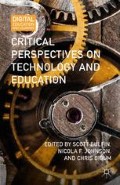Abstract
Humans, unlike some species, have a blind spot that derives from an absence of photoreceptor cells in the retina. We usually don’t notice our blind spot because the other eye helps the brain fill in the missing information. This means, as Leonard Mlodinow (2012) suggests, that reality is a little less straightforward than we might imagine. He puts it this way: “senses plus mind equals reality.”
Access this chapter
Tax calculation will be finalised at checkout
Purchases are for personal use only
Preview
Unable to display preview. Download preview PDF.
References
Ball, S. J. (2006). Education policy and social class: The selected works of Stephen J Ball. London: Routledge.
Barad, K. M. (2007). Meeting the universe halfway: Quantum physics and the entanglement of matter and meaning. Durham: Duke University Press.
Bigum, C. (2012a). Edges, exponentials and education: Disenthralling the digital. In L. Rowan & C. Bigum (Eds.), Transformative approaches to new technologies and student diversity in futures oriented classrooms: Future Proofing Education (pp. 29–43). Dordrecht: Springer.
Bigum, C. (2012b). Schools and computers: Tales of a digital romance. In L. Rowan & C. Bigum (Eds.), Transformative approaches to new technologies and student diversity in futures oriented classrooms: Future Proofing Education (pp. 15–28). Dordrecht: Springer.
Bowker, G. C., & Star, S. L. (1999). Sorting things out: Classification and its consequences. Cambridge, MA: MIT Press.
Bromley, H., & Apple, M. W. (Eds.). (1998). Education/technology/power: Educational computing as a social practice. Albany: State University of New York Press.
Chabris, C., & Simons, D. J. (2012). The invisible gorilla and other ways our intentions deceive us. New York: Crown.
Cuban, L. (1986). Teachers and machines: The classroom use of technology since 1920. New York: Teachers College Press.
Cuban, L. (2001). Oversold and underused: Computers in the classroom. Cambridge, MA: Harvard University Press.
Debele, M., & Plevyak, L. (2012). Conditions for successful use of technology in social studies classrooms. Computers in the Schools, 29(3), 285–299. doi: 10.1080/07380569.2012.703602
Edwards, R. (2011). Theory matters: Representation and experimentation in education. Educational Philosophy and Theory, 44(5), 522–534. doi: 10.1111/j.1469-5812.2010.00719.x
Koehler, M. J., & Mishra, P. (2009). What is technological pedagogical content knowledge? Contemporary Issues in Technology and Teacher Education (CITE Journal), 9(1), 60–70.
Latour, B. (2000). When things strike back: A possible contribution of “science studies” to the social sciences. British Journal of Sociology, 51(1), 107–123. doi: 10.1111/j.1468-4446.2000.00107.x
Latour, B. (2005). Reassembling the social: An introduction to actor-network-theory. Oxford: Oxford University Press.
Law, J. (2004). After method: Mess in social science. London: Routledge.
Law, J. (2007). Pinboards and books: Juxtaposing, learning and materiality. In D. W. Kritt & L. T. Winegar (Eds.), Education and technology: Critical perspectives, possible futures (pp. 125–149). Lanham: Lexington Books.
Law, J. (2008). On sociology and STS. The Sociological Review, 56(4), 623–649. doi: 10.1111/j.1467-954X.2008.00808.x
Law, J. (2012). Collateral realities. In F. D. Rubio & P. Baert (Eds.), The politics of knowledge (pp. 156–178). London: Routledge.
Loveless, A. (2011). Technology, tedagogy and education: Reflections on the accomplishment of what teachers know, do and believe in a digital age. Technology, Pedagogy and Education, 20(3), 301–316.
Maddux, C. D., & Johnson, D. L. (2012). External validity and research in information technology in education. Computers in the Schools, 29(3), 249–252. doi: 10.1080/07380569.2012.703605
Mishra, P., & Koehler, M. J. (2006). Technological pedagogical content knowledge: A framework for teacher knowledge. Teachers College Record, 108(6), 1017–1054.
Mlodinow, L. (2012). Subliminal: The revolution of the new unconscious and what it teaches us about ourselves (1st ed.). London: Allen Lane.
Mol, A. (1999). Ontological politics: A word and some questions. In J. Law & J. Hassard (Eds.), Actor network theory and after (pp. 74–89). Oxford: Blackwell.
Nicholls, A. V. (2009). The social life of the computer in ramingining. Unpublished PhD thesis, Charles Darwin University, Darwin. Retrieved from http://espace.cdu.edu.au/eserv/cdu:9267/Thesis_CDU_9267_Nicholls_A.pdf
Noble, D. D. (1991). The classroom arsenal: Military research, information technology and public education. London: Falmer.
Pickering, A. (1995). The mangle of practice: Time, agency, and science. Chicago: University of Chicago Press.
Rowan, L. (2013). “What price success?” The impact of the quest for “student satisfaction” on university academics. International Journal of Pedagogies and Learning, 8(2), 132–146.
Siemens, G. (2005). Connectivism: A learning theory for the digital age. International Journal of Instructioal Technology and Distance Learning, 2(1), np. Retrieved from http://www.itdl.org/Journal/Jan_05/article01.htm
Simons, D. J., & Chabris, C. F. (1999). Gorillas in our midst: Sustained inattentional blindness for dynamic events. Perception, 28, 1059–1074.
Sørensen, E. (2009). The materiality of learning: Technology and knowledge in educational practice. Cambridge: Cambridge University Press.
Sproull, L., & Kiesler, S. (1991). Connections: New ways of working in the networked organization. Cambridge, MA: The MIT Press.
Tenner, E. (1996). Why things bite back: Technology and the revenge of unintended consequences (1st ed.). New York: Knopf.
Verran, H. (1999). Staying true to the laughter in Nigerian classrooms. In J. Law & J. Hassard (Eds.), Actor network theory and after (pp. 136–155). Oxford: Blackwell.
Zhao, Y., Pugh, K., Sheldon, S. & Byers, J. L. (2002). Conditions for classroom technology innovations. Teachers College Record, 104(3), 482–515.
Editor information
Copyright information
© 2015 Scott Bulfin, Nicola F. Johnson, and Chris Bigum
About this chapter
Cite this chapter
Bigum, C., Rowan, L. (2015). Gorillas in Their Midst: Rethinking Educational Technology. In: Bulfin, S., Johnson, N.F., Bigum, C. (eds) Critical Perspectives on Technology and Education. Palgrave Macmillan’s Digital Education and Learning. Palgrave Macmillan, New York. https://doi.org/10.1057/9781137385451_2
Download citation
DOI: https://doi.org/10.1057/9781137385451_2
Publisher Name: Palgrave Macmillan, New York
Print ISBN: 978-1-349-48124-8
Online ISBN: 978-1-137-38545-1
eBook Packages: Palgrave Education CollectionEducation (R0)

